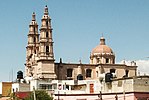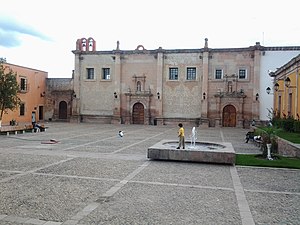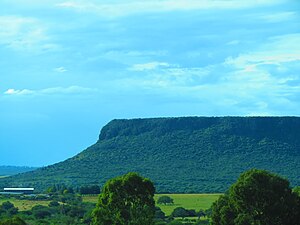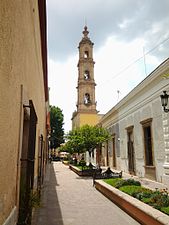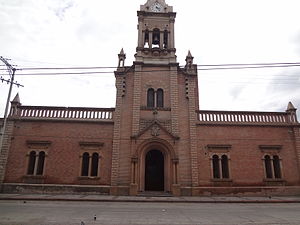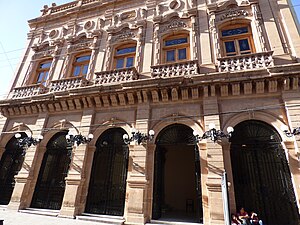Lagos de Moreno
Lagos de Moreno | |
|---|---|
Municipality and City | |
From left to right and from top to bottom: Templo del Calvario, Teatro José Rosas Moreno, Parroquia Nuestra Señora de la Asunción, Parroquia De Nuestra Señora De La Luz | |
| Nickname: Athens of Mexico (Atenas de México) | |
| Motto: Adversus populos Xiconaqui et Custique fortitudo | |
 Location of the municipality in Jalisco | |
| Coordinates: 21°21′N 101°55′W / 21.350°N 101.917°W | |
| Country | |
| State | |
| Founded | March 31, 1563 |
| Founded as | Villa de Santa María de los Lagos |
| Founded by | Hernando Martel and Pedro de Anda |
| Named for | Pedro Moreno and the historical lakes in the region |
| Government | |
| • Municipal President | Tecutli José Guadalupe Gómez Villalobos (Movimiento Ciudadano) |
| Area | |
• Municipality | 2,514 km2 (971 sq mi) |
| • City | 24.72 km2 (9.54 sq mi) |
| Elevation | 1,942 m (6,371 ft) |
| Population (2020 census)[1] | |
• Municipality | 172,403 |
| • Density | 69/km2 (180/sq mi) |
| • City | 111,569 |
| • City density | 4,500/km2 (12,000/sq mi) |
| Demonym | Laguense |
| Time zone | UTC-6 (Central Standard Time) |
| • Summer (DST) | UTC-5 (Central Daylight Time) |
| Area code | 474 |
Lagos de Moreno (Spanish: [ˈlaɣos ðe moˈɾeno] ) is a city and municipality in the State of Jalisco, Mexico. Lagos is located in the region of Los Altos de Jalisco, within the macroregion of the Bajío, one of the most highly developed areas in Latin America.[2] Lagos de Moreno is occasionally known as the "Athens of Jalisco", owing to the numerous writers and poets who were born there.[3][4]
Lagos de Moreno was founded as Villa Santa Maria de los Lagos on March 31, 1563, by Don Hernando Martel, an Andalusian conquistador. The town was the economic and cultural center of a region that eventually attracted many ranchers. By 1600 there were over 20,000 cattle in the region. Santa Maria continued growing both physically and culturally, and by the 1800s, the town was elevated to a city and renamed to Lagos de Moreno in honor of Pedro Moreno. Lagos de Moreno was the site of the signing of several important political documents, the two identically named but unrelated Convenios de Lagos. The arts flourished in the city during the latter half of the 19th century, but this literary boom decreased somewhat after the Mexican Revolution, especially during the 1940s. Recently, Lagos de Moreno has become an important cultural and tourist destination thanks to its rich history and architecture, some of which still stands from the 17th century.
As of the 2020 census, the city had a population of 111,569, making it the 6th largest city in the state of Jalisco.[5][6] The municipality had a population of 172,403 in 2020.[1] It includes many other outlying small communities, the largest of which are Paso de Cuarenta (San Miguel de Cuarenta) and Los Azulitos.[7]
Etymology
[edit]The conquistador Hernando Martel gave Lagos de Moreno its original name, Villa de Santa Maria de los Lagos (Town of Saint Mary of the Lakes). The town's name was derived from Saint Mary, the townspeople's chosen patron saint, and the numerous lakes that used to be scattered across the valley. The town was renamed on April 9, 1829, as Lagos de Moreno in honor of Mexican independence hero Pedro Moreno, who was born in the city.
History
[edit]Pre-hispanic era
[edit]The origins of Lagos de Moreno date to its founding as Pechichitlán or Teziziatlan by Ahnuvic VII in about 1028 BCE. Then the city served as a capital for the Chichimecatlalli fiefdom.[7] In the 12th century, semi-nomadic Guachichiles occupied the valley and dominated an extensive area stretching from present-day San Juan de los Lagos to southern Coahuila. Before the colonization of Mexico began, indigenous culture thrived in this area, with notable pre-Hispanic architecture being established at Rincón de Mesa, Sauceda, and El Maguey.[8]
Colonial era
[edit]After the fall of the Aztec Empire, explorers set out to explore the western frontier in the Bajio Region. The Spanish expansion in Nueva Galicia was slowed down by several tribes in the vicinity, such as the semi-nomadic Chichimecas and the Guachichiles. To the east of Pechititan, the Guamares inhabited the Guanajuato area, and to the west, the Zacatecos lived. The Zacateco caudillos (chiefs), Xiconaqui and Custique, along with the Chichimecas, struck down multiple Spanish invasions from 1550 to 1590 in the well-known Chichimeca War.
However, encomenderos gradually occupied the Bajio. The first Spaniard to build a hacienda in the Laguense valley was Don Diego de Ibarra.[9] Even so, in 1551, a group of Chichimecas attacked his ranch (La Sauceda and San Antonio) and killed all his animals. The constant raids in the area made, for the time being, made settlement of the Lagos region impossible.[8]
Founding of Lagos
[edit]
After decades of constant combat and raids, the first Spanish authorities of the region were appointed; the priest of Teocaltiche and the Mayor of Teocaltiche had the region stretching from Teocaltiche to the Lagos valley as their jurisdiction. Later, the Royal Audiencia of Nueva Galicia ordered the Mayor of Teocaltiche, Don Hernando Martel from Seville, to establish a town in the vicinity of Pechichitan. The new settlement was founded jointly with the first priest and vicar of the local parish, father Juan de Cuenca Virues, who also participated in the official founding of the Real Comanja mine in 1561.[8] As such, on March 31, 1563, Villa de Santa María de los Lagos was founded by Martel and Cuenca, along with around 100 Spanish noble families.[7]
Development
The residents of Santa Maria chose the Virgin Mary as the namesake of their town and Saint Sebastian as a minor patron saint. The settlement and its surroundings became quite appealing to ranchers; by 1600 around 20,000 head of cattle were active in the Lagos valley, facilitating the eventual creation of the charreria-style rodeo.[9] The increasing population of the area contributed to the naming of the first ordinary Mayor of Santa Maria de los Lagos, the miner Pedro Marfil from Guanajuato. Marfil would be succeeded by Gonzalo Vazquez Baladez, the first and only clergyman to-date to serve as mayor of the town.
The town continued to grow steadily in the 17th century, benefiting from the general prosperity of the Golden Age of the Spanish Empire. In 1615, a new jail was inaugurated, and 1621 saw the construction of a third parish temple with a tower that would be completed by 1685. Religious buildings were created often during this period; the Convent of the Poor Capuchins of Saint Joseph was founded and the construction of the Parish Church of Our Lady of the Assumption and the Temple of Our Lady of the Rosary began during this time.[8]
Mexican War of Independence
[edit]
Santa Maria de los Lagos, like the rest of New Spain, underwent rapid political change in the early 1800s. Local lawyer Francisco Primo de Verdad y Ramos spoke openly to the colonial authorities, advocating for Mexican independence. However, he soon died under mysterious circumstances in the dungeon of the Mexico City Trustee building. In the initial phase of the war, Father Miguel Hidalgo y Costilla visited Santa Maria de los Lagos and provided religious services there, and recruited some families for the fight against the forces of the Spanish Viceroy.[9]
Independence to present
[edit]| UNESCO World Heritage Site | |
|---|---|
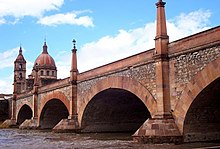 The historic Lagos Bridge with the Temple of Our Lady of the Light in the distance | |
| Location | Lagos de Moreno, Jalisco, Mexico |
| Criteria | ii, iv |
| Reference | 1351-017 |
| Inscription | 2010 (34th Session) |
In 1823, the Convenio de Lagos (Agreement of Lagos) was signed in Santa Maria by Nicolas Bravo, Pedro Celestino Negrete, and Luis Quintanar, establishing the Free and Sovereign State of Jalisco. On March 27, 1824, Santa Maria was given the title of city.[8] On April 9, 1829, the city was renamed as Lagos de Moreno in memory of insurgent General Pedro Moreno (1775–1817), a founding father of Mexico who led forces against Spanish authorities in the Mexican War of Independence.[7][8]
In 1855, a second and similarly titled Convenio de Lagos (Agreement of Lagos) was signed in Lagos de Moreno, in which Manuel Doblado and Antonio de Haro y Tamariz recognized the Plan of Ayutla, thus joining the movement to topple conservative President Antonio López de Santa Ana. During the Reform War, Lagos de Moreno changed hands between liberal and conservative forces multiple times until an eventual liberal victory in 1861.[8]
During the Mexican Revolution in the 1910s, residents of Lagos de Moreno like Mariano Azuela and Francisco Guerrero Ramirez joined the fighting.[8][9] In the subsequent Cristero War, the nearby Mesa Redonda was the site of a battle between federal troops and rebel forces.[10]
In 1963, Lagos de Moreno celebrated the 400th anniversary of its founding. In recent times, the city has received several important titles. It has been named an Area of Historical Monuments by the National Institute of Anthropology and History (INAH) in 1989, a World Heritage Site on the Camino Real "Tierra Adentro" by UNESCO on August 1, 2010, and "Pueblo Mágico" by SECTUR on November 16, 2012.[8][9]
Geography
[edit]Climate
[edit]Lagos de Moreno has a subtropical highland climate (Köppen climate classification Cwb) with mild temperatures year round.[11] Temperatures are generally similar for any given month, but daily high and low fluctuations can be very sharp in the winter due in part to the city's altitude and its uneven surroundings. Winters are mild with an average maximum temperature of 23 °C (73.4 °F) in January although nighttime temperatures are often cold, with an average minimum temperature of 3 °C (37.4 °F).[12] Many days are sunny, averaging around 15-19 clear days per month and precipitation is low.[13] Nighttime temperatures regularly fall below 0 °C (32.0 °F) but extended periods of frost are rare.[13]
The Bajio's two main seasons are the rainy season and the dry season. The rainy season, which runs from June to October, sees an increase in precipitation and humidity, with July and August being the months with the most precipitation. The record high was 42.0 °C (107.6 °F) on March 26, 1942[14] and the record low was −9.0 °C (15.8 °F) on January 24, 1955.[14] The table below shows detailed statistics on the climate of Lagos de Moreno.
| Climate data for Lagos de Moreno (1991–2020 normals, extremes 1942–2020) | |||||||||||||
|---|---|---|---|---|---|---|---|---|---|---|---|---|---|
| Month | Jan | Feb | Mar | Apr | May | Jun | Jul | Aug | Sep | Oct | Nov | Dec | Year |
| Record high °C (°F) | 35.5 (95.9) |
39.0 (102.2) |
42.0 (107.6) |
37.5 (99.5) |
41.5 (106.7) |
40.0 (104.0) |
36.0 (96.8) |
36.0 (96.8) |
34.5 (94.1) |
39.5 (103.1) |
34.0 (93.2) |
33.0 (91.4) |
42.0 (107.6) |
| Mean daily maximum °C (°F) | 23.5 (74.3) |
25.8 (78.4) |
28.0 (82.4) |
30.1 (86.2) |
31.2 (88.2) |
29.5 (85.1) |
27.4 (81.3) |
27.3 (81.1) |
26.8 (80.2) |
26.7 (80.1) |
25.2 (77.4) |
23.8 (74.8) |
27.1 (80.8) |
| Daily mean °C (°F) | 13.5 (56.3) |
15.2 (59.4) |
17.3 (63.1) |
19.7 (67.5) |
21.5 (70.7) |
21.9 (71.4) |
20.6 (69.1) |
20.5 (68.9) |
20.0 (68.0) |
18.4 (65.1) |
15.9 (60.6) |
13.9 (57.0) |
18.2 (64.8) |
| Mean daily minimum °C (°F) | 3.3 (37.9) |
5.1 (41.2) |
6.6 (43.9) |
9.2 (48.6) |
11.8 (53.2) |
14.3 (57.7) |
13.9 (57.0) |
13.6 (56.5) |
13.1 (55.6) |
10.0 (50.0) |
6.5 (43.7) |
3.9 (39.0) |
9.3 (48.7) |
| Record low °C (°F) | −9.0 (15.8) |
−7.5 (18.5) |
−4.5 (23.9) |
−1.0 (30.2) |
1.0 (33.8) |
3.0 (37.4) |
4.0 (39.2) |
5.0 (41.0) |
1.0 (33.8) |
−3.0 (26.6) |
−6.0 (21.2) |
−5.2 (22.6) |
−9.0 (15.8) |
| Average precipitation mm (inches) | 14.4 (0.57) |
10.7 (0.42) |
9.4 (0.37) |
9.4 (0.37) |
27.5 (1.08) |
110.8 (4.36) |
146.7 (5.78) |
118.7 (4.67) |
98.2 (3.87) |
38.5 (1.52) |
12.4 (0.49) |
10.3 (0.41) |
607.0 (23.90) |
| Average precipitation days (≥ 0.1 mm) | 1.8 | 1.2 | 1.1 | 1.3 | 4.0 | 10.5 | 13.7 | 12.2 | 10.0 | 4.5 | 1.4 | 1.3 | 63.0 |
| Average relative humidity (%) | 59 | 53 | 48 | 48 | 51 | 64 | 70 | 73 | 72 | 68 | 64 | 64 | 61 |
| Mean monthly sunshine hours | 231.3 | 240.7 | 273.5 | 282.5 | 289.9 | 230.4 | 224.8 | 223.3 | 203.2 | 241.4 | 244.8 | 214.5 | 2,900.3 |
| Source 1: Servicio Meteorológico Nacional[12][14] | |||||||||||||
| Source 2: Colegio de Postgraduados (sun and humidity 1951–1980)[13] | |||||||||||||
Topography
[edit]
Lagos de Moreno is situated 1,942 meters (6,371 feet) above mean sea level.[15] Lagos is located in the region of Los Altos de Jalisco, within the macroregion of the Bajío, one of the most highly developed areas in Latin America.[2] The city's vicinity is quite mountainous and hilly, with the nearby Mesa Redonda being a particularly notable formation.[16]
Flora and fauna
[edit]The nearby Mesa Redonda is home to many unique species of flora. There, two species of cactus endemic only to Jalisco flourish, with one of these species only being endemic to the Mesa Redonda, particularly its very steep slopes, protecting it from predators.
Many animals call the Lagos valley home, with fauna including hares, rabbits, deers, and boars. Residents of nearby ranches have commented on the presence of coyotes and snakes in rural areas. Areas like the Mesa Redonda have been utilized by locals to gather vegetables straight from nature, particularly prickly pear cacti.[16]
Demographics
[edit]As of the 2020 Mexican census, the city had a population of 111,569, making it the 6th largest city in the state of Jalisco.[5][6] The municipality as a whole had an estimated population of 164,981 in 2015.[17] The municipality has a slightly higher female population, with 88,426 females compared to 83,977 males.[6]
In Lagos de Moreno city, 38,024 dwellings were enumerated, with 38,002 of these being private households. Of the private residences, 30,020 were inhabited; and in turn, of the inhabited private residences: 29,817 had non-dirt flooring; 29,64 had electricity; 29,919 had sanitary facilities; and 29,941 had drainage.[6]
Notable people
[edit]Athletics
[edit]- Luis Fernando Macías, professional cyclist, silver medalist at the 2009 Pan-American Road and Track Championship
- Armando Reynoso Gutiérrez, baseball player for the Mexico national team, Mexican Baseball Hall of Fame member
- Isaác Brizuela Muñoz, Mexican-American footballer for C.D. Guadalajara
- Carmelo Reyes González, former professional wrestler
Culture
[edit]- Lola Álvarez Bravo, famed photographer, prominent figure of the post-Mexican Revolution artistic renaissance
- Juan Pablo Villalobos, author and entrepreneur
- José Rosas Moreno, 19th-century writer, fableist, and poet
- Mariano Azuela González, 19th/20th-century literary critic, novelist, and essayist
Politics
[edit]- Pedro de Anda, Spanish conquistador and founder of Lagos de Moreno
- Luis Alfonso de Alba Góngora, Mexican under-secretary for Latin America in the Secretary of Foreign Relations, former Mexican Representative to the United Nations
- Ramón Muñoz Gutiérrez, Senator of Jalisco in the Mexican Senate of the Republic
- Emilio González Márquez, former Governor of Jalisco
- Pedro Moreno, general and father of the Mexican War of Independence
- Francisco Primo de Verdad y Ramos, 18th-century lawyer and politician of colonial New Spain
Religion
[edit]- Juan Manuel Martín del Campo, Roman Catholic priest and exorcist, titled as Venerable by Pope Francis
Government
[edit]Mayors and municipal presidents
[edit]Subjects and citizens who have served as mayors or municipal presidents of Lagos de Moreno
| Officer | Term | Office | Notes |
| Pedro Marfil[18] | 1563-1567 | Ordinary mayor | Founder |
| Luis López | 1567-1569 | Ordinary mayor | Founder |
| Pedro de Villafaña | 1569-1580 | Ordinary mayor | Founder |
| Lope Sánchez de Uréchiga | 1580-1609 | Ordinary mayor | |
| Lorenzo de Padilla Dávila | 1609-1611 | Ordinary mayor | |
| Fernando de Villegas Jara | 1611-1616 | Ordinary mayor | |
| Juan de Arredondo y Bracamontes | 1616-1624 | Senior mayor | |
| Pedro de Aranda | 1624-1650 | Senior mayor | |
| Captain Antonio de Villegas Jara | 1650-1651 | Senior mayor | |
| Joseph González | 1651 | Senior mayor | |
| Captain Antonio de Esquivel y Vargas | 1653 | Senior mayor | |
| Antonio Ximénez de Castro | 1659 | Senior mayor | |
| Captain Juan de Alarcón Faxardo | 1662 | Senior mayor | |
| Captain Diego González de la Torre | 1663 | Senior mayor | |
| Captain Diego Flores de la Torre | 1672 | Senior mayor | |
| Francisco de Villaviciosa | 1679 | Senior mayor | |
| Captain Juan Rincón Gallardo | 1688 | Senior mayor | |
| Felipe de Otadui y Avendaño | 1692 | Senior mayor | |
| Fernando Hurtado de Mendoza | 1694 | Senior mayor | |
| Captain Jerónimo Antonio Chacón | 1707 | Senior mayor | |
| Sebastián de Manzano | 1727 | Senior mayor | |
| Juan Pérez Franco y Hermosillo | 1736 | Senior mayor | |
| Miguel Jerónimo del Villar | 1737 | Senior mayor | |
| Bernabé Felipe de Torres Ortega | 1738 | Senior mayor | |
| Carlos de San Gil y Ram. | 1758 | Senior mayor | |
| Francisco Javier de Arriola | 1775 | Senior mayor | |
| Juan de Anaya | 1778 | Senior mayor | |
| Diego Romero de Chávez | 1790 | Senior mayor | Main character in the book El Alcalde de Lagos y otras consejas (The Mayor of Lagos and other stories),[19] by Alfonso de Alba Martín (1957) |
| Alonso de Ceballos y Villagutierre | 1794 | Senior mayor | |
| Juan José de Echarte | 1808–1810 | Military commander | |
| José María Sanromán | 1809 | Senior mayor | |
| Buenaventura Anaya | 1810 | Senior mayor | |
| Rafael Flores | 1811–1814 | Military commander | |
| Hermenegildo Rebuelta | 1814–1821 | Military commander | |
| Quirino Sanromán | 1821–1824 | Military commander | |
| Juan Crescencio Hermosillo | 1843 | Political chief | |
| Bruno Rey | 1857 | Political chief | |
| Juan García Rebollo | 1858 | Prefect | |
| Prudencio Topete | 1860 | Political chief | |
| Juan Zermeño | 1863 | Prefect, conservative | |
| Bernardo Olivero | 1866 | Prefect, conservative | |
| Albino Aranda | 1868 | Political chief | |
| Antonio Barajas | 1876 | Political chief | |
| Juan Alatorre | 1873 | Political chief | |
| Camilo Anaya | 1874 | Political chief | |
| José María Sanromán | 1875 | Political chief | |
| Pedro Vega | 1880 | Political chief | |
| José Ignacio Torres | 1881 | Political chief | |
| Andrés Michel | 1883 | Political chief | |
| Colonel Francisco de Paula Méndez | 1887 | Political chief | |
| José de Urrea | 1888 | Political chief | |
| Abraham Arróniz | 1890 | Political chief | |
| M. Morelos | 1891 | Political chief | |
| Abraham Arróniz | 1892 | Political chief | |
| Lt. Col. Ignacio Montenegro | 1895 | Political chief | |
| José María Arce | 1897 | Political chief | |
| Lt. Col. Jesús L. Patiño | 1898 | Political chief | |
| José María Gutiérrez | 1900 | Political chief | |
| Mayor Rosendo Híjar y Haro | 1901 | Political chief | |
| Margarito González Rubio | 1903 | Political chief | |
| Jesús Gómez Portugal | 1909 | Political chief | |
| Lorenzo I. Calderón | 1911 | Political chief | |
| Alberto Macedo | 1913 | Political chief | |
| Lt. Col. Ismael Hurtado | 1914 | Political chief |
| Municipal president | Term | Party | Notes |
| Juan Zúñiga | 1916 | ||
| Benjamín E. Mora | 1917 | ||
| Pedro Pons | 1918 | ||
| Leonardo Larios Paz | 1919 | ||
| Ramón Vázquez | 1920 | ||
| José Vega González | 1921 | ||
| Francisco Montoya | 1923 | ||
| Luciano Castañeda | 1925 | ||
| Fernando Zermeño | 1926 | ||
| Ricardo Anaya | 1927 | ||
| Miguel Gómez Portugal | 1928 | ||
| Ramón E. Rivera | 1929 | PNR |
|
| Jesús Pérez | 1934 | PNR |
|
| Carlos A. Cuervo | 1935 | PNR |
|
| Jacobo Lomelín | 1935 | PNR |
|
| Francisco Carrera | 1936 | PNR |
|
| Miguel Araujo Soto | 1938 | PRM |
|
| Salvador J. Camarena | 1943 | PRM |
|
| Luis Nungaray Garza | 1944 | PRM |
|
| Alfonso Márquez | 1945 | PRM |
|
| Ignacio Cedillo | 1946 | PRI |
|
| José María Padilla | 1947 | PRI |
|
| Abraham Vega | 1948 | PRI |
|
| Manuel Vega | 1950 | PRI |
|
| Enrique Núñez Ortiz | 1953 | PRI |
|
| Alfonso Escobar | 1954 | PRI |
|
| Francisco Carrera Hernández | 1956 | PRI |
|
| Enrique Núñez Ortiz | 1953 | PRI |
|
| Roberto Moreno | 1958 | PRI |
|
| José Gutiérrez Zermeño | 1959 | PRI |
|
| Abraham Vega Padilla | 1960 | PRI |
|
| Juan José Gómez | 1961 | PRI |
|
| Juan Anaya Gómez | 01-01-1962–31-12-1964 | PRI |
|
| Carlos González Gómez | 1965 | PRI |
|
| José A. Villagrán | 1966 | PRI |
|
| Rubén Martín Urzúa | 1967 | PRI |
|
| Jesús Delgado Pérez | 01-01-1968–31-12-1970 | PRI |
|
| Manuel Flores Tostado | 01-01-1971–31-12-1973 | PRI |
|
| Jorge Sanromán Quiñones | 01-01-1974–31-12-1976 | PRI |
|
| Alfredo Gallardo Fregoso | 01-01-1977–31-12-1979 | PRI |
|
| Teodoro Esparza Rojo | 1980–1982 | PRI |
|
| Víctor Atilano Gómez[20] | 1983–1985 | PDM |
|
| Tranquilino Martín | 1985 | PDM |
|
| Trinidad Velázquez | 1986 | ||
| Sergio Esparza | 1987 | ||
| Emigdio Rico Santana | 1988 | ||
| Ignacio Padilla Hernández[21] | 1989–1992 | PRI |
|
| Benjamín Gazcón Torres[22] | 1992–1995 | PRI |
|
| Víctor Manuel Larios Muñoz[23] | 1995–1997 | PAN |
|
| Francisco Javier Pérez Romero[24] | 01-01-1998–31-12-2000 | PRI |
|
| Francisco Rafael Torres Marmolejo[25] | 01-01-2001–2003 | PAN |
|
| Saúl González Fuentes[26] | 01-01-2004–31-12-2006 | PAN |
|
| Francisco Rafael Torres Marmolejo[27][28] | 01-01-2007–31-12-2009 | PAN |
|
| José Brizuela López[29] | 01-01-2010–30-09-2012 | PRI Panal |
Coalition "Alliance for Jalisco" |
| Hugo René Ruiz Esparza Hermosillo[30] | 01-10-2012–30-09-2015 | PRI PVEM |
Coalition "Compromise for Jalisco" |
| Juan Alberto Márquez de Anda[31] | 01-10-2015–30-09-2018 | PRI PVEM |
|
| Tecutli José Guadalupe Gómez Villalobos[32][33] | 01-10-2018–02-03-2021 | PAN PRD MC |
Applied for a leave to run for reelection, which he got |
| José Ignacio Ángel Cervantes[34] | 02-03-2021–30-09-2021 | PAN PRD MC |
Acting municipal president |
| Tecutli José Guadalupe Gómez Villalobos[35] | 01-10-2021– | MC |
Was reelected on 06-06-2021 |
Gallery
[edit]-
Maria Soine de Helguerra Regional Public Library
-
Parroquia Nuestra Señora de la Asunción
-
N. Sra. de la Luz Church at sunset
-
The Municipal Palace of Lagos de Moreno
-
San José de Gracia de Pobres Capuchinas Convent
-
José Rosas Moreno Theatre
-
The Temple of Calvario
-
La Mesa Redonda
-
La Merced Temple
-
Comanja Temple
-
Miguel Leandro Guerra School of Arts and Trades
-
N. Sra. de la Luz Church
-
San Felipe de Jesús Temple
-
Asunción de María Park
-
Panteon de la Soledad
-
San Miguel Church
-
Teatro José Rosas Moreno
-
N. Sra. del Refugio Church
Transportation
[edit]The city used to be served by the Francisco Primo de Verdad National Airport (IATA: LOM). The nearest airport, Del Bajio International Airport (IATA: BJX) is located near Silao, Guanajuato, an hour's drive away.[36]
References
[edit]- ^ a b Citypopulation.de Population of Lagos de Moreno municipality with localities
- ^ a b Cruz, Osiel (16 August 2013). "Bajío, el nuevo milagro mexicano".
- ^ "Lagos de Moreno 2020, #52 places to visit in jalisco, top things to do, reviews, best tourist places to visit for 4 - 7 Days, photo gallery | HelloTravel Mexico". www.hellotravel.com. Retrieved 2020-04-03.[permanent dead link]
- ^ Luciérnaga, La (2011-06-25). "La Atenas de Jalisco: Lagos de Moreno: "La Atenas de Jalisco"". La Atenas de Jalisco. Retrieved 2020-04-03.
- ^ a b Citypopulation.de Population of cities & towns in Jalisco
- ^ a b c d INEGI (2016-01-01). "México en cifras". www.inegi.org.mx (in Spanish). Retrieved 2023-06-05.
- ^ a b c d "Lagos de Moreno". mexicanroutes.com. Retrieved 2020-04-03.
- ^ a b c d e f g h i "Fundación e historia de Lagos de Moreno". www.elclima.com.mx (in Spanish). Retrieved 2020-04-03.
- ^ a b c d e Cana, Marco. "Lagos de Moreno Pueblo Magico". www.pueblosmexico.com.mx. Retrieved 2020-04-03.
- ^ Contreras, Karla Zafiro Rizo (2015-12-16). "Adiós a la mesa redonda. La segunda Cristiada en Lagos de Moreno". Diversae. Revista del Seminario de Historia Mexicana (in Spanish). 1 (1).
- ^ Kottek, M.; J. Grieser; C. Beck; B. Rudolf; F. Rubel (2006). "World Map of the Köppen-Geiger climate classification updated" (PDF). Meteorol. Z. 15 (3): 259–263. doi:10.1127/0941-2948/2006/0130. Retrieved December 22, 2012.
- ^ a b "Lagos de Moreno (DGE) Normales climatológicas 1991-2020" (in Spanish). Servicio Meteorológico Nacional. Retrieved February 27, 2024.
- ^ a b c "Normales climatológicas para Lagos de Moreno, Jalisco" (in Spanish). Colegio de Postgraduados. Archived from the original on February 21, 2013. Retrieved January 10, 2013.
- ^ a b c "Extreme Temperatures and Precipitation for Lagos de Moreno 1942-2020" (in Spanish). Servicio Meteorológico National. Retrieved February 27, 2024.
- ^ "Lagos de Moreno, Jalisco Mines". The Diggings™. Retrieved 2020-04-04.
- ^ a b Moreno, Radio UdeG Lagos de (2018-07-31). "Mesa redonda, el emblema natural de Lagos de Moreno". UDG TV (in European Spanish). Retrieved 2020-04-04.
- ^ "Número de habitantes. Jalisco". cuentame.inegi.org.mx. Retrieved 2020-04-03.
- ^ "Enciclopedia de los Municipios y Delegaciones de México. Jalisco. Lagos de Moreno" (in Spanish). Archived from the original on 14 May 2019. Retrieved 5 February 2022.
- ^ "El alcalde de Lagos". La Voz del Norte (in Spanish). 11 September 2011. Retrieved 5 February 2022.
- ^ "Consejo Electoral del Estado de Jalisco. CEEJ. Cómputo del Consejo Electoral del Estado de Jalisco en las Elecciones de munícipes, 1982. Lagos de Moreno. Partido Demócrata Mexicano (PDM): 6611 votos. PRI: 4574 votos. PAN: 2173 votos" (PDF) (in Spanish). Retrieved 5 February 2022.
- ^ "Consejo Electoral del Estado de Jalisco. CEEJ. Resultados de la elección de munícipes, 1988. Lagos de Moreno. PRI: 8525 votos. Partido Demócrata Mexicano (PDM): 4926 votos. PAN: 2685 votos" (PDF) (in Spanish). Retrieved 5 February 2022.
- ^ "Consejo Electoral del Estado de Jalisco. CEEJ. Elección de munícipes, 1992. Lagos de Moreno. PRI: 11931 votos. PAN: 7148 votos" (PDF) (in Spanish). Retrieved 5 February 2022.
- ^ "Consejo Electoral del Estado de Jalisco. CEEJ. Elección de munícipes, 1995. Lagos de Moreno. PAN: 18122 votos. PRI: 10328 votos. Partido Demócrata Mexicano (PDM): 5974 votos" (PDF) (in Spanish). Retrieved 5 February 2022.
- ^ "Consejo Electoral del Estado de Jalisco. CEEJ. Resultados de la elección de munícipes, 1997. Lagos de Moreno. PRI: 13893 votos. PAN: 11455 votos. Partido Demócrata Mexicano (PDM): 10780 votos. PRD: 1554 votos" (PDF) (in Spanish). Retrieved 5 February 2022.
- ^ "Consejo Electoral del Estado de Jalisco. CEEJ. Resultados de la elección de munícipes del 12 de noviembre de 2000. Lagos de Moreno. PAN: 17709 votos. PRI: 10546 votos. PVEM: 4200 votos. Partido Alianza Social (PAS): 1914 votos. Convergencia: 1452 votos. PRD: 387 votos" (PDF) (in Spanish). Retrieved 5 February 2022.
- ^ "Consejo Electoral del Estado de Jalisco. CEEJ. Integración de votos correspondientes a cada partido por municipio, elecciones del año 2003. Lagos de Moreno. PAN: 18182 votos. PRI: 12580 votos. Partido Alianza Social (PAS): 8981 votos. PVEM: 1624 votos. PRD: 1162 votos" (PDF) (in Spanish). Retrieved 5 February 2022.
- ^ "Listado de presidentes municipales electos, Jalisco" (PDF) (in Spanish). Retrieved 5 February 2022.
- ^ "Consejo Electoral del Estado de Jalisco. CEEJ. Resultado de los cómputos municipales, 5 de julio de 2006. Lagos de Moreno. PAN: 28962 votos. PRI: 15800 votos. PRD-PT: 3658 votos. PVEM: 2948 votos. Partido Nueva Alianza (Panal): 1102 votos" (PDF) (in Spanish). Retrieved 5 February 2022.
- ^ "Instituto Electoral y de Participación Ciudadana del Estado de Jalisco. IEPC Jalisco. Proceso electoral 2009. Ayuntamiento de Lagos de Moreno. PRI-Panal: 26582 votos. PAN: 19481 votos. PRD: 1994 votos. PVEM: 1950 votos" (PDF) (in Spanish). Retrieved 5 February 2022.
- ^ "Instituto Electoral y de Participación Ciudadana del Estado de Jalisco. IEPC Jalisco. Integración ayuntamientos 2012. Anexo V. Lagos de Moreno. PRI-PVEM: 28368 votos. PAN: 26408 votos. PT-MC: 6024 votos. PRD: 1609 votos" (PDF) (in Spanish). Retrieved 5 February 2022.
- ^ "Instituto Electoral y de Participación Ciudadana del Estado de Jalisco. IEPC Jalisco. Resultados de la elección de munícipes. Proceso electoral local ordinario 2015. Integración de ayuntamientos 2015. Anexo V. Lagos de Moreno. PRI-PVEM: 23455 votos. MC: 17331 votos. PAN-PRD: 11919 votos" (PDF) (in Spanish). Retrieved 5 February 2022.
- ^ "Instituto Electoral y de Participación Ciudadana del Estado de Jalisco. IEPC Jalisco. Integración de ayuntamientos, 2018. Anexo 4. Lagos de Moreno. PAN-PRD-MC: 41387 votos. PRI: 14095 votos. PT-Morena-PES: 7240 votos. PVEM: 776 votos. PRD: 704 votos" (PDF) (in Spanish). Retrieved 5 February 2022.
- ^ "Tecutli Gómez pide licencia de su cargo como Primer Edil de Lagos de Moreno". UDG-TV (in Spanish). 3 March 2021. Retrieved 5 February 2022.
- ^ "Tecutli Gómez pide licencia de su cargo como primer edil; José Ignacio Ángel Cervantes quedará al frente del Gobierno Municipal de manera interina". Tribuna Lagos. La Voz de los Alteños (in Spanish). 2 March 2021. Retrieved 5 February 2022.
- ^ "Instituto Electoral y de Participación Ciudadana del Estado de Jalisco. IEPC Jalisco. Proceso electoral concurrente 2021. Integración de Ayuntamientos, 2021. Lagos de Moreno. MC: 25214 votos. PAN: 17178 votos. Hagamos: 5914 votos. PRI: 5737 votos. Morena: 3315 votos" (in Spanish). Retrieved 5 February 2022.
- ^ "Del Bajío International - Mexico". World Airport Codes. Retrieved 2020-04-04.
Sources
[edit]- Link to tables of population data from Census of 2005 INEGI: Instituto Nacional de Estadística, Geografía e Informática
- Jalisco Enciclopedia de los Municipios de México
External links
[edit]- Fotografias de Lagos de Moreno www.alxkueyar.com
- Laguenses en el exterior www.laguenses.com
- Ayuntamiento de Lagos de Moreno Official website






